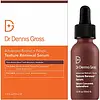What's inside
What's inside
 Key Ingredients
Key Ingredients

 Benefits
Benefits

 Concerns
Concerns

 Ingredients Side-by-side
Ingredients Side-by-side

Water
Skin ConditioningPropanediol
SolventButyloctyl Salicylate
Skin ConditioningCarnitine
CleansingPolyglyceryl-6 Stearate
EmollientSalicylic Acid
MaskingGlycerin
HumectantPolyglyceryl-4 Oleate
EmulsifyingTocopherol
AntioxidantCetyl Hydroxyethylcellulose
Emulsion StabilisingGlyceryl Caprylate
EmollientSodium Anisate
AntimicrobialSodium Levulinate
Skin ConditioningPolyglyceryl-6 Behenate
Emulsion StabilisingXanthan Gum
EmulsifyingChamomilla Recutita Flower Extract
MaskingSodium Hyaluronate
HumectantCamellia Sinensis Leaf Extract
AntimicrobialAloe Barbadensis Leaf Juice
Skin ConditioningWater, Propanediol, Butyloctyl Salicylate, Carnitine, Polyglyceryl-6 Stearate, Salicylic Acid, Glycerin, Polyglyceryl-4 Oleate, Tocopherol, Cetyl Hydroxyethylcellulose, Glyceryl Caprylate, Sodium Anisate, Sodium Levulinate, Polyglyceryl-6 Behenate, Xanthan Gum, Chamomilla Recutita Flower Extract, Sodium Hyaluronate, Camellia Sinensis Leaf Extract, Aloe Barbadensis Leaf Juice
Water
Skin ConditioningPropylene Glycol
HumectantDimethyl Isosorbide
SolventPolyglyceryl-10 Laurate
Skin ConditioningGlycerin
HumectantEthoxydiglycol
HumectantLactic Acid
BufferingHydroxypropyl Starch Phosphate
Mandelic Acid
AntimicrobialRetinol
Skin ConditioningBakuchiol
AntimicrobialNephelium Lappaceum Leaf Extract
Skin ConditioningFerulic Acid
AntimicrobialSqualane
EmollientLinoleic Acid
CleansingSalicylic Acid
MaskingSalix Alba Bark Extract
AstringentPhospholipids
Skin ConditioningSoy Isoflavones
Skin ConditioningSodium Hyaluronate
HumectantSaccharide Isomerate
HumectantUbiquinone
AntioxidantSodium PCA
HumectantHexylresorcinol
AntimicrobialQuercetin
AntioxidantAdenosine
Skin ConditioningMorus Alba Bark Extract
Skin ConditioningPanthenol
Skin ConditioningGlycolic Acid
BufferingMaltodextrin
AbsorbentXanthan Gum
EmulsifyingLeuconostoc/Radish Root Ferment Filtrate
AntimicrobialCaprylic/Capric Triglyceride
MaskingPotassium Hydroxide
BufferingPolysorbate 20
EmulsifyingSodium Phytate
Citric Acid
BufferingSodium Citrate
BufferingPhenoxyethanol
PreservativeSodium Benzoate
MaskingPotassium Sorbate
PreservativeWater, Propylene Glycol, Dimethyl Isosorbide, Polyglyceryl-10 Laurate, Glycerin, Ethoxydiglycol, Lactic Acid, Hydroxypropyl Starch Phosphate, Mandelic Acid, Retinol, Bakuchiol, Nephelium Lappaceum Leaf Extract, Ferulic Acid, Squalane, Linoleic Acid, Salicylic Acid, Salix Alba Bark Extract, Phospholipids, Soy Isoflavones, Sodium Hyaluronate, Saccharide Isomerate, Ubiquinone, Sodium PCA, Hexylresorcinol, Quercetin, Adenosine, Morus Alba Bark Extract, Panthenol, Glycolic Acid, Maltodextrin, Xanthan Gum, Leuconostoc/Radish Root Ferment Filtrate, Caprylic/Capric Triglyceride, Potassium Hydroxide, Polysorbate 20, Sodium Phytate, Citric Acid, Sodium Citrate, Phenoxyethanol, Sodium Benzoate, Potassium Sorbate
 Reviews
Reviews

Ingredients Explained
These ingredients are found in both products.
Ingredients higher up in an ingredient list are typically present in a larger amount.
Glycerin is already naturally found in your skin. It helps moisturize and protect your skin.
A study from 2016 found glycerin to be more effective as a humectant than AHAs and hyaluronic acid.
As a humectant, it helps the skin stay hydrated by pulling moisture to your skin. The low molecular weight of glycerin allows it to pull moisture into the deeper layers of your skin.
Hydrated skin improves your skin barrier; Your skin barrier helps protect against irritants and bacteria.
Glycerin has also been found to have antimicrobial and antiviral properties. Due to these properties, glycerin is often used in wound and burn treatments.
In cosmetics, glycerin is usually derived from plants such as soybean or palm. However, it can also be sourced from animals, such as tallow or animal fat.
This ingredient is organic, colorless, odorless, and non-toxic.
Glycerin is the name for this ingredient in American English. British English uses Glycerol/Glycerine.
Learn more about GlycerinSalicylic Acid (also known as beta hydroxy acid or BHA) is a well-known ingredient for treating skin that struggles with acne and clogged pores. It exfoliates both the skin's surface and deep within the pores to help clear out buildup, control oil, and reduce inflammation.
Unlike AHAs (alpha hydroxy acids), salicylic acid is oil-soluble. This allows it to penetrate into pores which makes it especially effective for treating blackheads and preventing future breakouts.
Salicylic acid is also known for its soothing properties. It has a similar structure to aspirin and can calm inflamed or irritated skin, making it a good option for acne-prone skin that is also sensitive.
Concentrations of 0.5-2% are recognized by the U.S. FDA as an over-the-counter topical acne product.
It can cause irritation and/or dryness if one's skin already has a compromised moisture barrier, so it's best to focus on repairing that before introducing this ingredient into your routine.
While salicylic acid does not increase sun sensitivity, it’s still important to wear sunscreen daily to protect your skin.
If you are looking for the ingredient called BHA or Butylated Hydroxyanisole, click here.
Learn more about Salicylic AcidSodium Hyaluronate is hyaluronic acid's salt form. It is commonly derived from the sodium salt of hyaluronic acid.
Like hyaluronic acid, it is great at holding water and acts as a humectant. This makes it a great skin hydrating ingredient.
Sodium Hyaluronate is naturally occurring in our bodies and is mostly found in eye fluid and joints.
These are some other common types of Hyaluronic Acid:
Learn more about Sodium HyaluronateWater. It's the most common cosmetic ingredient of all. You'll usually see it at the top of ingredient lists, meaning that it makes up the largest part of the product.
So why is it so popular? Water most often acts as a solvent - this means that it helps dissolve other ingredients into the formulation.
You'll also recognize water as that liquid we all need to stay alive. If you see this, drink a glass of water. Stay hydrated!
Learn more about WaterXanthan gum is used as a stabilizer and thickener within cosmetic products. It helps give products a sticky, thick feeling - preventing them from being too runny.
On the technical side of things, xanthan gum is a polysaccharide - a combination consisting of multiple sugar molecules bonded together.
Xanthan gum is a pretty common and great ingredient. It is a natural, non-toxic, non-irritating ingredient that is also commonly used in food products.
Learn more about Xanthan Gum